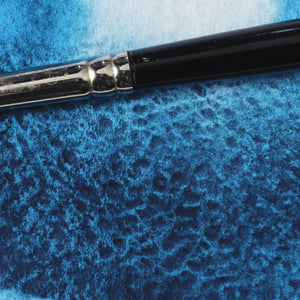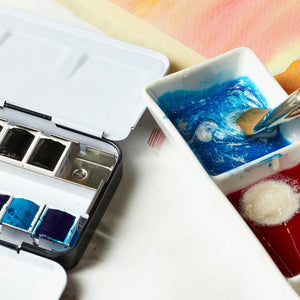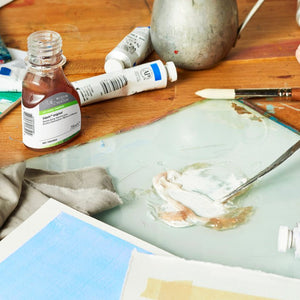
“Your business, Winsor, is to make colour. Mine is to use them.”
This was JMW Turner’s response to gentle criticism from William Winsor, who was concerned about the artist’s occasional lack of forward thinking when it came to using colour that would last. It must have been hard for a genius like Turner to pocket his pride and take a more considered approach, but Winsor’s point is as valid now as it was then: for the work of an artist to last, they need to choose colour that will stand the test of time. This simple message remains one of the fundamental aspects of the work of Winsor & Newton today.
The early years of JMW Turner
Joseph Mallord William Turner began his career at the age of 11, copying architectural drawings, colouring antiquarian engravings and painting landscapes in watercolour. His first exhibited work was the watercolour A View of the Archbishop’s Palace, Lambeth in 1790, aged 15. This emerging artistic talent, combined with driving ambition and entrepreneurial skill, enabled him to become, in the words of the artist and critic Matthew Collings, “about the most entertaining, if not the most profound, artist there has been”.
Experimentation with pigments
The story of Turner, the man who experimented endlessly with new pigments and mixing methods, is one of trial, success, and occasional error. The research of Dr. Joyce Townsend, senior conservation scientist at Tate and an expert on Turner and his materials, has revealed that his medium was mainly gum arabic – along with traces of gum tragacanth and varying levels of sugar or honey.
Turner’s watercolour palette
Pigments found within Turner’s watercolours include gamboge, quercitron yellow, vermilion, various iron oxides including ochres, umbers, and siennas, Indian yellow, green lake, Prussian blue, indigo, cobalt blue, blue verditer, and rose madder. He used watercolours in a block form and there is evidence he made some, if not all of them, himself.
Transition to oil paintings
Turner turned to oil colours in his early twenties to gain more professional standing and recognition, and exhibited his first oil painting, Fishermen at Sea, at the Royal Academy when he was 21. In oil, he used genuine ultramarine (lapis lazuli), white lead, and a very toxic yellow, orpiment – also known as king’s yellow or, chemically, arsenic sulphide. By the early 19th century, he had replaced it with chrome yellow. There is evidence in the 1800 painting Dolbadern Castle that he used the lead pigment Naples yellow.
Use of lake pigments
He also used unspecified lake pigments, made by fixing a dye on a base compound such as alumina which turned it into a pigment. This gave the pigments great transparency in oil but less so in water. The choice of dye and base influenced the lightfastness. Turner used at least one red lake, a green, and a geranium shade, and all were prone to fading. Some early versions of rose madder had poor lightfastness, but the process developed by the outstanding English colour-maker, George Field, was and still is superior. This process is still followed by Winsor & Newton today.
Combining oil and watercolour techniques
Turner’s love of both oil and watercolour meant he experimented with using the same pigment for his oil paintings as he did in his watercolours. He would have discovered that gamboge does not work in oil nor white lead (flake white) in water. There is evidence he employed linseed oil, poppy oil, and, to a lesser extent, walnut oil in his oil paintings, though in The Fighting Temeraire from 1839, he used only walnut oil.
Adoption of new pigments
Documents at Tate show that Turner closely followed pigment development and used new pigments as they appeared. This interest led him to use new pigments in favour of earlier ones with inferior or unsuitable properties. For example, he replaced smalt, which was said to be “deficient in impure air”, with cobalt blues that arrived after 1807.
The influence of chromium
The yellows that were discovered and used in Turner’s time followed the isolation of the metal chromium. A French chemist, Nicolas-Louis Vauquelin, worked on the process to isolate and prepare lead chromate pigments for over ten years, producing a range of yellow shades from chrome lemon to chrome deep yellow. These were first made in England in 1816 and widely used by Turner in both oil and water.
Greens in Turner’s palette
Turner also used Scheele’s green (toxic copper arsenite), which he had substituted with emerald green by the 1830s. Although chemically similar to Scheele’s green, this was an improvement as it was more intense and durable. When viridian became available, he combined it with emerald in paintings from the 1840s.
The challenges of preservation
Many of the pigments Turner used, such as cochineal carmine and the chrome yellow shades, were known to fade in his lifetime. He used natural indigo, but this has faded dramatically, leaving behind grey or red skies where it was originally mixed with black or vermilion.
Impact of environmental factors
Of course, along with light, the rate of fading in his paintings has been affected by factors such as humidity and atmospheric pollution. Turner preferred absorbent grounds and tended to keep his canvases in extremely damp conditions. This combination led to mould growth, discolouration, embrittlement, and flaking, which would have happened in his lifetime.
The legacy of Turner’s experimentation
Turner’s desire to experiment with materials and fugitive colour, and his passion to achieve an effect rather than care for the finished work, did not help the preservation of his work – and illustrates well William Winsor’s genuine concerns about the artist, who had become a friend and frequent visitor to Winsor & Newton. Even a genius needs a little advice now and again. Whether he or she uses it is another thing entirely.













![WN PWC KAREN KLUGLEIN BOTANICAL SET [FRONT]](http://www.winsornewton.com/cdn/shop/files/136444.jpg?crop=center&v=1740654068&width=20)
![WN PWC KAREN KLUGLEIN BOTANICAL SET [OPEN 2]](http://www.winsornewton.com/cdn/shop/files/136447.jpg?crop=center&v=1740654068&width=20)
![WN PWC ESSENTIAL SET [FRONT]](http://www.winsornewton.com/cdn/shop/files/137583.jpg?crop=center&v=1740762356&width=20)
![WN PWC ESSENTIAL SET [OPEN]](http://www.winsornewton.com/cdn/shop/files/137581.jpg?crop=center&v=1740762356&width=20)
![W&N GALERIA CARDBOARD SET 10X12ML [B014096] 884955097809 [FOP]](http://www.winsornewton.com/cdn/shop/files/138855.jpg?crop=center&v=1740761853&width=20)
![W&N GALERIA CARDBOARD SET 10X12ML 884955097809 [OPEN]](http://www.winsornewton.com/cdn/shop/files/138856.jpg?crop=center&v=1740761853&width=20)

![W&N PROMARKER 24PC STUDENT DESIGNER 884955043295 [FRONT]](http://www.winsornewton.com/cdn/shop/files/78674_d4d78a69-7150-4bf4-a504-3cb5304b0f80.jpg?crop=center&v=1721326116&width=20)

![W&N PROFESSIONAL WATER COLOUR TYRIAN PURPLE [SWATCH]](http://www.winsornewton.com/cdn/shop/files/136113.jpg?crop=center&v=1724423390&width=20)
![W&N WINTON OIL COLOUR [COMPOSITE] 37ML TITANIUM WHITE 094376711653](http://www.winsornewton.com/cdn/shop/files/9238_5073745e-fcfe-4fad-aab4-d631b84e4491.jpg?crop=center&v=1721326117&width=20)
![W&N WINTON OIL COLOUR [SPLODGE] TITANIUM WHITE](http://www.winsornewton.com/cdn/shop/files/131754_19b392ee-9bf6-4caf-a2eb-0356ec1c660a.jpg?crop=center&v=1721326118&width=20)